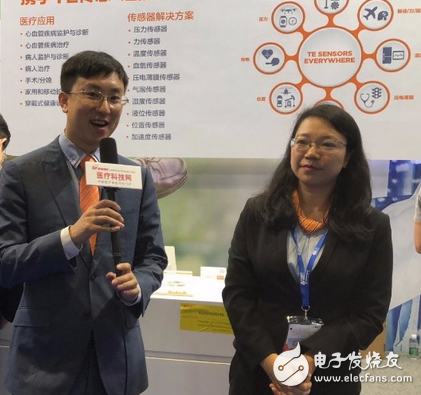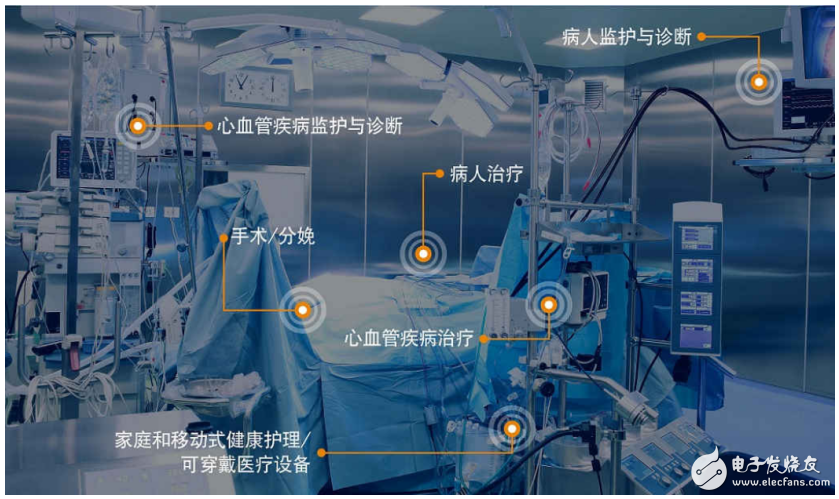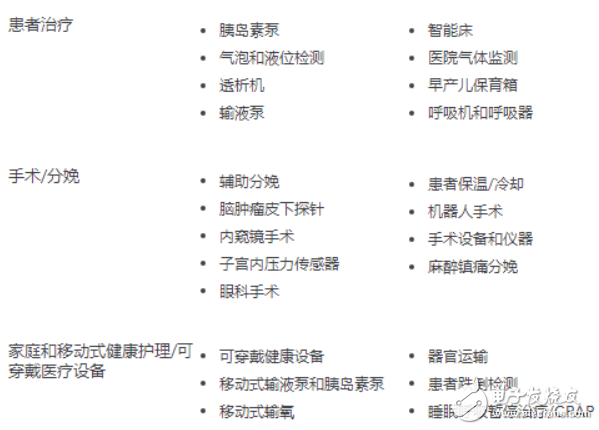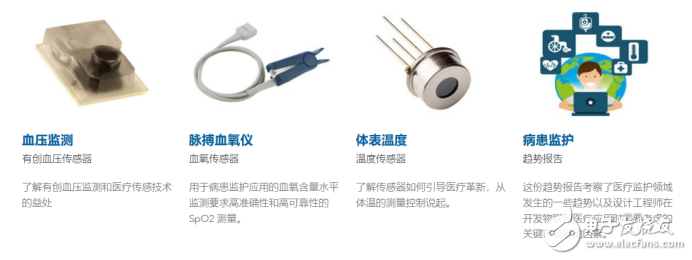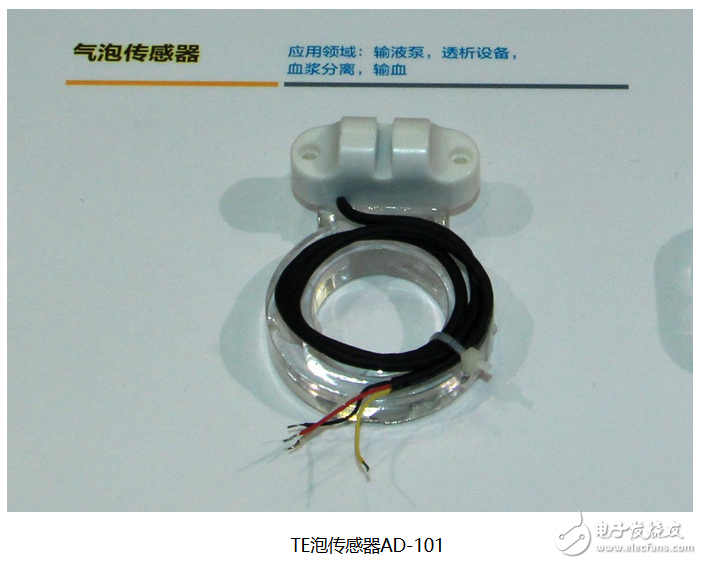Modern medical treatment is inseparable from electronic technology. From the most familiar B-ultrasound, X-ray, nuclear magnetic examination to minimally invasive, bridge, etc., all are developed due to the rapid development of electronic technology. Among them, the sensor plays a crucial role. It is an important channel for connecting the human body and the machine, providing the most accurate and timely data and status to the processor or physician. If there is a problem at the source, everything after that is wrong, the electronics in the medical equipment, instruments and probes. The system relies on sensor signals for control operations, accurate diagnosis and treatment. For medical sensors, reliability, miniaturization, high precision, and low power consumption are the most important features. Recently, Liao Hongyun, regional sales manager of TE ConnecTIvity (TE) Sensors Division, head of the Asia-Pacific medical industry, said in an interview with the media, "The advantages of TE sensors are mainly reflected in quality, localization and customer communication. We have been stressed that The company's vision is not only for business profit, but also for human health. In the medical field, the choice of materials and the design of the entire process are rigorous. Although in the project, we will face cost pressure, but Engineers always adhere to the quality priority, and will definitely optimize the cost performance based on the quality." Liao Hongyun, Regional Sales Manager, Sensors Division, TE ConnecTIvity (TE), Asia Pacific TE medical sensor introduction In 2014, TE expanded its existing sensor business with the acquisition of Measurement SpecialTIes, American Sensor Technologies and Macro Sensor, and ranks among the world's largest sensor companies. The sensor companies acquired by TE have passed various certifications, including ISO 13485 and FDA, to meet the stringent requirements of medical applications. At present, for TE, focusing on four major areas, including medical, electric vehicles, smart factories and data centers, the medical sensor market is also one of the markets that TE needs to develop after entering the sensor field. According to Liao Hongyun, TE medical sensors have covered eight major fields, namely piezoelectric film sensors, pressure sensors, humidity sensors, temperature sensors, force sensors, displacement sensors, ultrasonic sensors and photoelectric sensors, to meet the various needs of the medical market. Liao Hongyun said that most of the current sales of TE sensors come from traditional medical applications. Compared with consumer-grade sensor products, although the principle is the same, the level is different, and the people facing it are different. Similarly, medical applications are similar to industrial sensors. There are higher requirements in terms of size, precision and biocompatibility. Industry-driven This is a picture I like, you may not be able to cover all the knowledge of the medical industry, but TE offers solutions covering a wide range of clinical medical applications. No matter how good the TE products are, they will eventually be implemented on the product side. As Vitaliy Epshteyn, Chief Technology Officer and Senior Director of TE Healthcare, said: “What sets TE apart is that most of our medical products are custom products. This requires a lot of collaboration throughout the design and development process. In turn, we have the best solution to meet our customers' needs. Our customers have a design or engineering goal to talk to us early in the process. Our engineers are then able to collaborate with customers and involve them in the process. Every step. Our sales team also works with our customers to integrate ideas and innovations with our customers' engineers." Liao Hongyun said that customers do not care about the specific technology of the sensor, but are more concerned with the implementation of the function, so TE should provide a wider range of technologies and applications to meet industry applications. Liao Hongyun believes that although medical innovation seems to be slower than other industries, medical innovation requires rigorous argumentation and long-term clinical recognition. How does TE's products achieve the best solution for customers? At present, TE is based on three areas to help customers innovate, according to the application classification can be divided into the monitoring market, medical diagnosis and treatment market and special markets. As shown, most applications of TE sensors The main application of the TE monitoring market In the care market, TE's invasive blood pressure monitoring enables continuous, accurate and reliable blood pressure monitoring in intensive care units, emergency rooms and operating rooms. The pulse oximeter measures the blood oxygen (SpO2) content accurately and reliably through photodiodes. TE offers a highly flexible SpO2 sensor with multiple wavelength options, providing components or complete pulse oximetry sensors (reusable sensors) And disposable sensors), miniature, low-cost transmitters and detector combinations to meet the different needs of customers. Similarly, for temperature sensors, TE offers NTC thermistors, thermopiles and digital temperature sensors to support various accuracy, packaging and performance requirements in different applications. Taking the nursery box as an example, medical practice has proven that accurate sensor control is essential for medical improvement if precise control of the neonatal local environment can improve medical outcomes and reduce mortality. For the medical diagnostics and therapeutic market, TE also offers a range of technologies including products and solutions. For example, in the field of force sensing, force sensors are rarely mentioned in medical devices, but in fact it is an indispensable solution because they play a key role in many critical applications, most notably infusion pumps. However, due to the complexity of the process and the high requirements, there are only a handful of companies that provide force sensors. For non-intrusive bubble detectors, TE's AD-101 bubble detection sensor is designed for non-intrusive continuous monitoring of bubble detection. It uses ultrasonic technology to actively locate any type of solid-free liquid flow interruption. These sensors provide continuous self-diagnosis and flexible assembly, enabling the most critical application designs to be implemented. In the field of dialysis equipment, since the blood that has undergone circulatory circulation is pumped into the blood vessel, it is necessary to monitor the blood blockage in the blood circuit outside the body, and it is necessary to precisely control the pressure of the blood vessel. If the pressure is too small or too small, the patient may be discomforted. Therefore, it is necessary to measure the pressure under vacuum and positive pressure by a plate-mounted pressure sensor. In addition, the dialysate delivery system requires pressure to control the rate of exchange of nutrients and waste materials and the cleaning rate of the dialysis process, so a stainless steel diaphragm pressure sensor is required to precisely control the fluid pressure. In order to prevent air from entering the patient's vein, it is necessary to detect bubbles in the extracorporeal blood circuit by means of a bubble detector. Continuous Positive Pressure Ventilation (CPAP) ventilator devices require sensors to continuously control airflow, pressure and humidity to maintain patient comfort and safety. To this end, TE offers a one-way and two-way design that includes a hot film gas flow sensor that helps doctors diagnose sleep apnea. In addition, the plate-mounted pressure sensor measures the air pressure of the blower. The piezoelectric film can detect the sleep state by measuring the vibration during the breathing process, and the temperature and humidity sensor can ensure the accuracy of the air output by the ventilator. TE also cooperates with forward-looking companies in the medical field to launch numerous innovative applications. The sleep sensor uses a piezoelectric film for human body sleep detection, which can be directly attached to the surface of the machine without affecting the mechanical movement of the mechanism, and has the advantages of wide frequency band, wide dynamic range, and high voltage sensitivity. The piezoelectric film is mounted under the mattress and does not touch the patient and does not affect sleep. Accurate measurements can be provided even through clothing, sick clothes or bed sheets. It can monitor parameters such as respiratory rate, heart rate, body movement, deep sleep, and light sleep time. It also includes catheter sensors, assisted fetal delivery and other applications. Sensors can also do a lot more interesting things, such as designer and manufacturer Chloe Meineck invented a device that helps people with dementia - the Music Memory Box. The user attaches the RF ID tag to a familiar object, such as a received award or a small gift. When you place an object in the center of the music memory box, the reader recognizes the RF ID number and then plays the corresponding music or song, which may recall memories that the patient has never touched. Meineck's project draws on the following medical research: the memory of people with dementia may be triggered by music, especially a song or piece of song that the patient has heard in the past. Focus on the telemedicine market In addition to combining advanced applications, TE has been focusing on a broader medical market, such as transferring healthcare to the home for telemedicine. Because trained clinicians are less directly involved in patient monitoring, healthcare professionals and medical centers are increasingly relying on sensor-equipped devices to track and detail patient health in the lowest risk. Home health devices become smarter when added with sensors, integrate with other systems, and deliver critical information remotely. For example, sensors can be used to detect skin temperature, vials, and even socks and pillows to pay attention to the state and pass the data to the hospital. If the situation is abnormal, the doctor can immediately treat it. “The human body is like a supercomputer with sensory input everywhere,†says Brian Ream, chief field application engineer at TE Sensors. “Even the body is secretly doing what we don’t know, and we can measure it very quickly. The more information we can capture and measure, the more we can understand the health of the patient.†Liao Hongyun said: "For telemedicine, it is a huge system. The sensor is only a part of it. Although it can't be said that it completely leads the industry, it is the most basic. At the same time, TE's connection technology also provides connectivity to the Internet. We are one of the few companies that have a large portfolio of products on the same platform, so we have a lot of opportunities." Intervene early in customer product development Liao Hongyun said that TE will customize customers for different markets. There are many cases in China. In the early stage of design, TE engineers have already docked with engineers. Including mechanical design, parameter design, inspection systems, test systems, etc. At the same time, TE has a broader sensor portfolio that can provide more accurate recommendations for early customer selection. Liao Hongyun found that customers in the Chinese market have made continuous progress in terms of technology and market expansion. From the earliest accessories to the current supply of machines, TE needs more and more customers. “Although some of our customers will produce their own sensors, because they are not experts in this area, there is no guarantee in terms of cost and stability, so we will still choose our cooperation.†Brian Ream also said that if sensor experts can participate in product design from the start, they can help the design team avoid major risks. Brian Ream proposes that because the US FDA and the European Community (CE) regulations require medical device OEMs to adopt a risk-based design approach throughout the design cycle, from design entry to final verification and acceptance testing, OEMs are managing this process. Vendors tend to ignore a vendor that can help them reduce design risk: sensor vendors. This usually happens when new medical devices with innovative patents are born. In these cases, some OEMs are reluctant to share design information with external vendors early in the design process. For medical device OEM project managers and designers, their sensor suppliers, especially supplier product experts, may play an important role in developing new products. If these sensor product experts are able to participate in product design from the start, they can help design teams avoid major risks because they typically have an in-depth understanding of sensor performance and often have years of experience in product enhancement design. Vitaliy Epshteyn, Chief Technology Officer and Senior Director of TE Medical, also said that the difference between TE is that most medical products are customized products. “This requires us to collaborate a lot during the entire design and development process to achieve satisfaction. The best solution for customer needs. Our customers have a design or engineering goal to talk to us early in the process. Our engineers are then able to collaborate with the customer and engage the customer in every step of the process. †About TE's future innovation In recent years, TE has entered the broader medical device market by acquiring Creganna Medical and AdvancedCath, which can better integrate sensors with other technologies. For example, the catheter blood flow measurement scheme developed by TE is introduced into different positions of the heart through a pair of matched thermistors, and the blood flow can be read by changing the temperature and volume. Liao Hongyun said that as an innovative company, TE always pays attention to market changes, pays attention to the needs of doctors in diagnosis and treatment, and pays attention to the patient's experience, and then changes the design. “For medical equipment products, design and production are very difficult and slow progress, so Chinese customers need to be more practical and meticulous. In addition, as people's living standards improve, health management and telemedicine are raised higher. Demand." Liao Hongyun concluded, "In terms of technology, there are still many needs to be overcome in the future in terms of precision, volume, materials and so on."
The latest Windows has multiple versions, including Basic, Home, and Ultimate. Windows has developed from a simple GUI to a typical operating system with its own file format and drivers, and has actually become the most user-friendly operating system. Windows has added the Multiple Desktops feature. This function allows users to use multiple desktop environments under the same operating system, that is, users can switch between different desktop environments according to their needs. It can be said that on the tablet platform, the Windows operating system has a good foundation.
Windows Tablet,New Windows Tablet,Tablet Windows Jingjiang Gisen Technology Co.,Ltd , https://www.gisentech.com